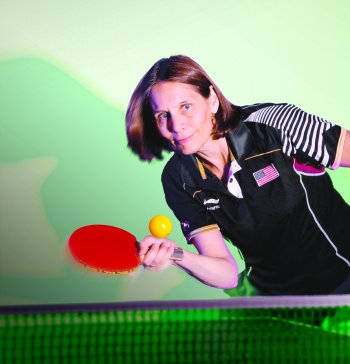In 1971, at the age of 15, Judy Bochenski joined a team of “ping pong diplomats” on a trip to China that helped pave the way for President Nixon’s breakthrough state visit a year later.
 ON THE BALL
ON THE BALL
In 1971, at the age of 15, Judy Bochenski joined a team of “ping pong diplomats” on a trip to China that helped pave the way for President Nixon’s breakthrough state visit a year later. Today Judy Bochenski Hoarfrost is the CEO of Portland-based paddlepalace.com, the nation’s top seller of table tennis equipment, with $2.5 million in annual sales, eight employees and its own line of ping-pong robots. The former national champion took a break from the daily barrage of orders to discuss table tennis, online niche retail and the surprisingly complicated world of ping-pong rubber.
How did you get so good at table tennis?
My father played while he was in the service in Korea so he was always interested in it. We always had a table in our house. Any time we moved we had to find a house with a room big enough for the table.
How did you start the business?
My parents opened a table tennis club in downtown Portland at the old Elk’s Club building. It was a big ballroom with chandeliers and carved angels on the ceiling. It was like a palace, so we called it Paddle Palace. People would come from all over the world for the tournaments. Then the lease got bought out and my father used that as seed money for starting an equipment company.
Was there any money in table tennis?
No. But my father was a real entrepreneur. He would hold a tournament every month and find sponsors. He would make plaques and do the calligraphy himself. Even the pop machine was an important source of revenue. He would put fingernail polish on the quarters to track where the money went. Years later I would come across a quarter downtown with fingernail polish on it and I would know where it came from.
The equipment has changed a lot since then.
There are so many types of rubber it is incredible — short pips, long pips, heavy spin, anti-topspin, combination rackets. You can put one type of rubber on one side of your paddle and another on the other side. Each type has different sponge thicknesses. We’ll have to figure out how many variations there are and put that number in our catalog.
Do you make products?
We assemble things. And we have a brand that we’ve developed, the Hunter brand. We also have Paddle Palace robots. They are selling really well. You see that blue container out there? It’s full of robots. I’m trying to get the robots out to a bigger market. We’re going to be selling on Amazon. We’re working on that.
If table tennis were to take off, your position would be strong.
Everyone I talk to loves table tennis, but not everyone thinks of it as a sport. It’s a grassroots sport. You can have a really good match between someone who is very old and a little kid. It will always be around for that reason. But we always feel that our sport has so much potential that hasn’t been fulfilled. Compare it to soccer. Soccer used to be nothing, but soccer did something to become huge. We need to figure out how to do that.
BEN JACKLET
Have an opinion? E-mail [email protected]


